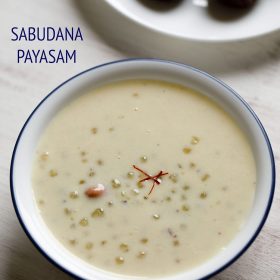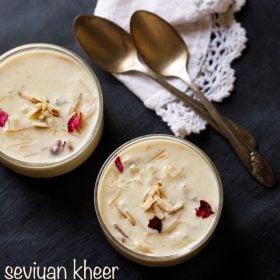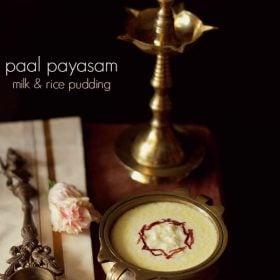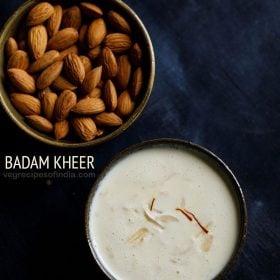
Dals/lentils are an integral source of proteins and other nutrients for us Indians, especially vegetarians and vegans. India is also the nation that produces the largest quantity of these food crops. Paruppu as it is known in South India, has uses in various dishes ranging from salty and savory to sweets like Paruppu Payasam. This is a Pasi Paruppu Payasam or Moong Dal Payasam – a creamy, decadent pudding of yellow moong lentils, jaggery, coconut milk and flavored with cardamom.
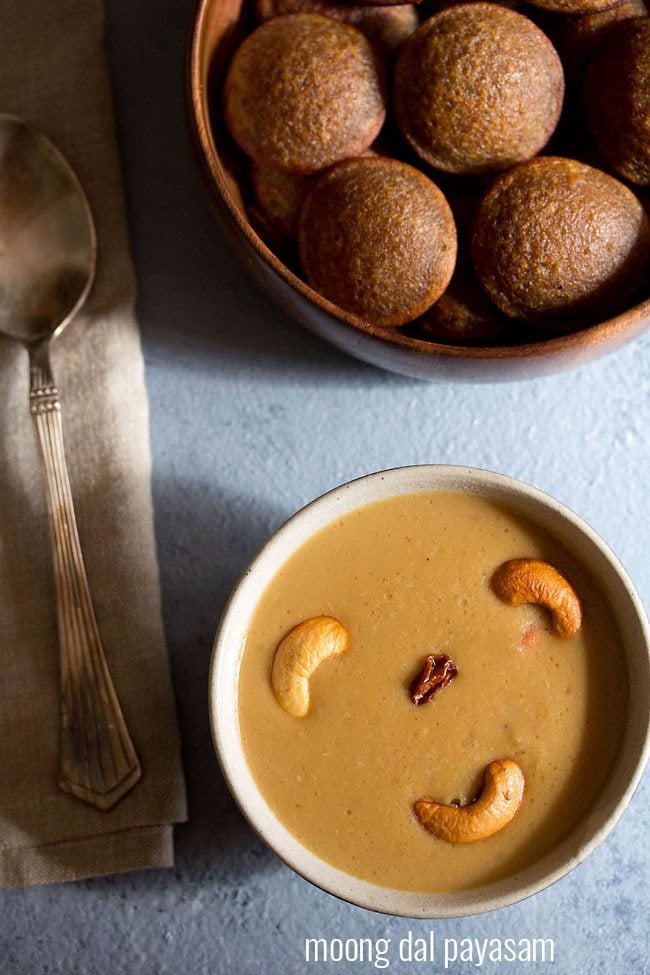

What is payasam
Just like curries, India is synonymous with kheer, which is simply a sweet pudding. Payasam as it is known in South India has one of the main ingredients milk, in which another base ingredient is cooked along with a sweetener and some flavorings. This explains the meaning of the Sanskrit word ‘ksheer (milk),’ as the origin of the word kheer.
A traditional Indian recipe is this Kheer prepared by boiling rice grains in a mixture of milk, sweeteners and flavorings like cardamom, saffron, nuts, dry fruits, etc.
But South Indian cuisine is known to use a range of paruppu (dals) in their payasams. So, you have different Paruppu Payasam like Pasi Paruppu Payasam with moong dal, Kadalai Paruppu Payasam with chana dal and so on.
Other food cultures of the world also have rice payasam like dishes. For instance, ‘moghli or meghli’ of Lebanese cuisine, ‘rizogalo’ of Greek cuisine, ‘arroz con leche’ of Spanish/Mexican cuisine and the British porridge. In India, West Bengal has ‘payesh’ and the North Indian Phirni can be considered as a close relative of the kheer.
More on Pasi Paruppu Payasam
Payasam is also that sweet dish which is usually made in most of the South Indian households during festive occasions. It is a common prasad served to devotees in temples as well. This Pasi Paruppu Payasam made with moong lentils is one of the tastiest versions of this dish.
At home, I make both kheer and Paruppu Payasam regularly. A delish dessert, this Pasi Paruppu Payasam is apt during festive celebrations. Also, a hit sweet ending on other special occasions and for guests. You can even make this payasam of pasi paruppu (moong dal) as an offering to deities or for your family and friends.
This Moong Dal Payasam recipe is a simple one, and anyone can make it by following it carefully. Make sure to use homemade coconut milk in this payasam, if you are making it as an offering to any deity or Lord Ganesha on Ganesh Chaturthi.
This Coconut Milk Recipe is going to show you the perfect way to prepare coconut milk at home. When preparing Pasi Paruppu Payasam for near and dear ones or guests, you can use either homemade or store-bought coconut milk.
Step-by-Step Guide
How to make Pasi Paruppu Payasam
Cooking moong dal
1. Rinse ½ cup moong dal (pasi paruppu) a couple of times. Take the moong dal and 1 cup water in a small pan. Place this pan in a pressure cooker. Add 1.5 cups water in the pressure cooker and pressure cook moong dal for 5 to 6 whistles or 9 to 10 minutes on medium heat. You can also cook the lentils directly in the cooker. In this case, you can add 1.5 cups water to the lentils and then pressure cook. The lentils can be cooked in a pan too.
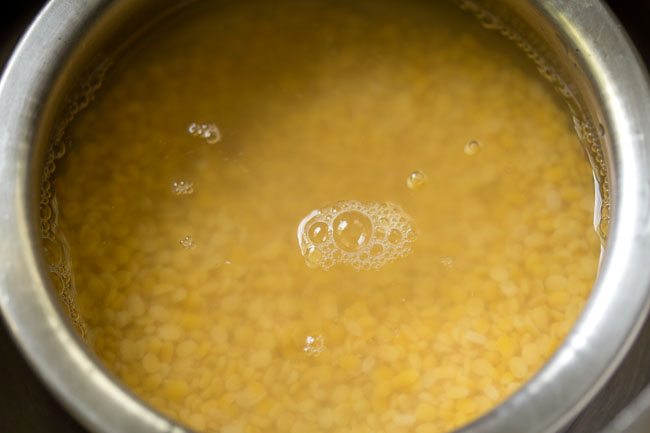

2. When the pressure settles down naturally, remove the lid and check the dal. It should be cooked well, and not be too pasty or lumpy.
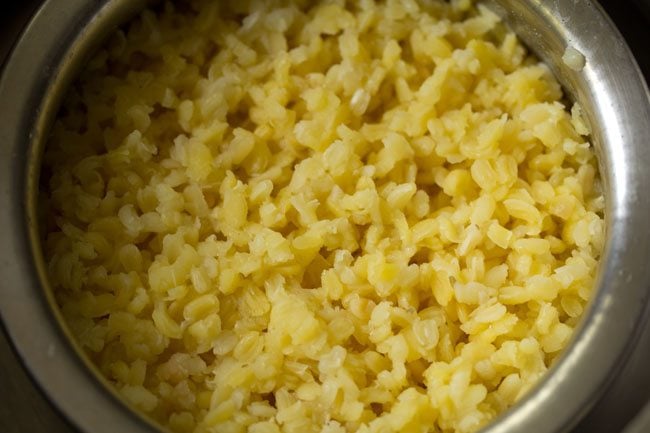

3. Pour the cooked moong dal and water in another pan or kadai.
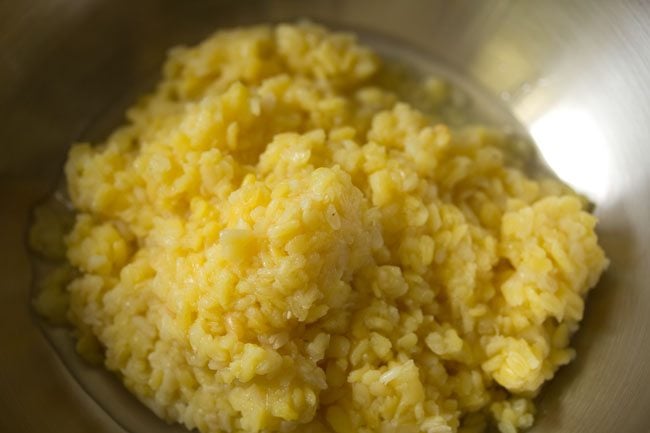

4. Mash the moong dal with a spoon.
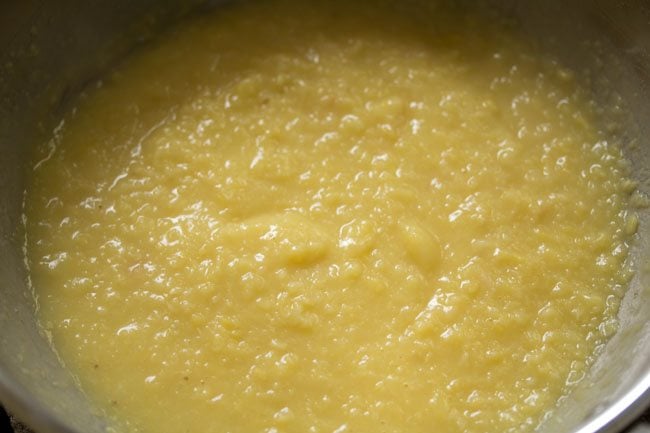

Making Pasi Paruppu Payasam
5. Add ½ cup thin coconut milk or water and mix well.
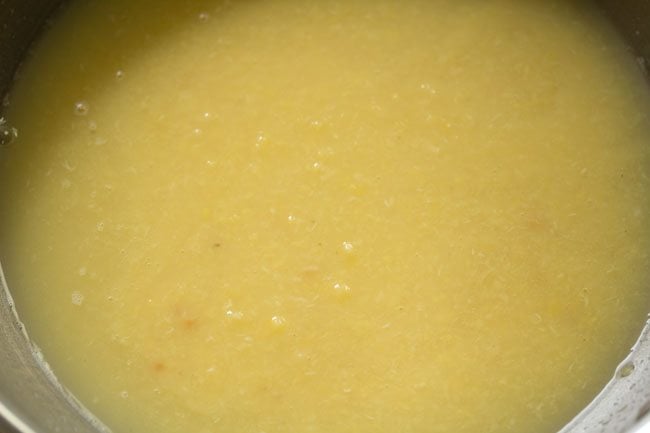

6. Add ¾ cup jaggery powder. For a less sweet taste, you can add ½ cup jaggery powder or grated jaggery. If the jaggery has a lot of impurities, then heat it in ⅓ cup water on low heat and stir till it melts. Then, filter and use this syrup.
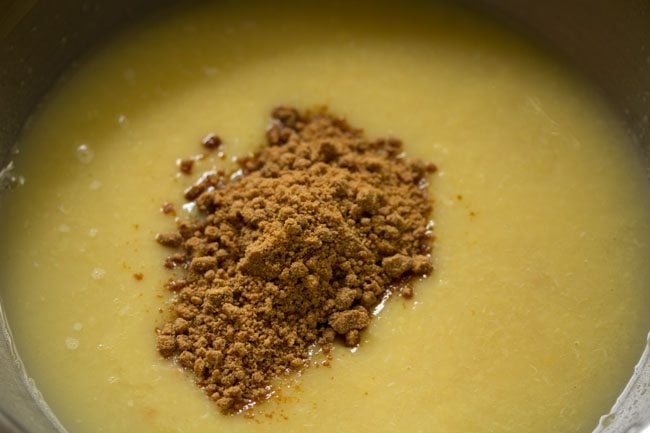

7. Keep the pan or kadai on stovetop and heat the mixture on low flame.
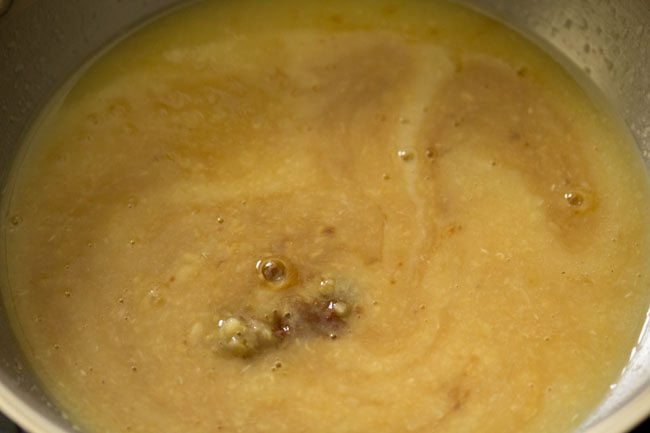

8. Keep on stirring so that the jaggery dissolves.
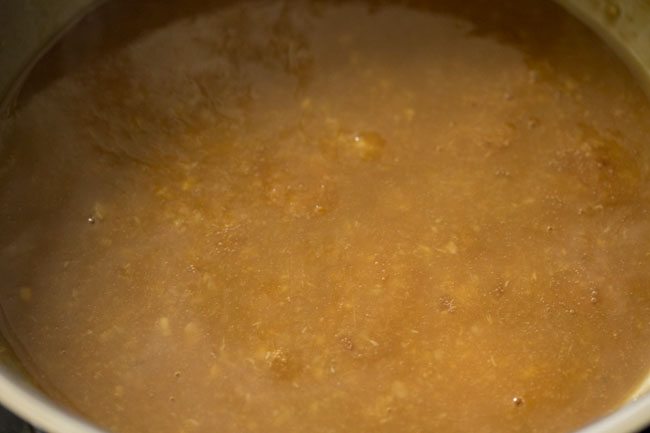

9. Once the jaggery has dissolves, add 1 cup thick coconut milk.
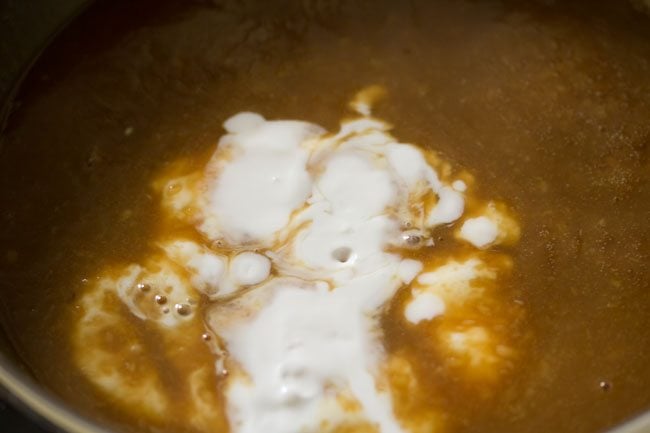

10. Mix very well and gently heat through for a minute or two. Switch off the heat and keep aside. Do not over heat or boil as the coconut milk can curdle.
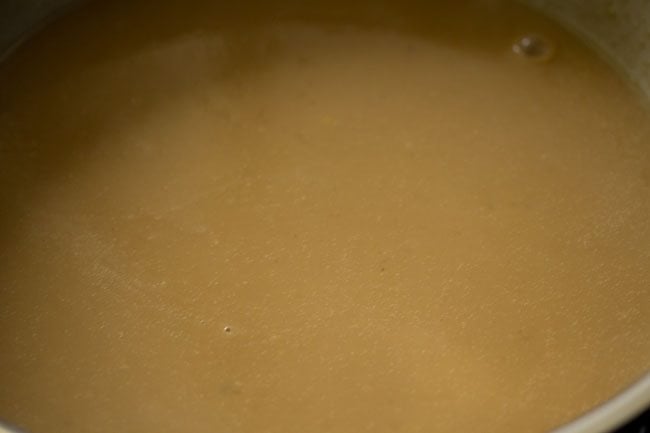

11. In a small pan or tadka pan, heat 2 tablespoons coconut oil. Add 12 to 15 cashews. Instead of coconut oil, you can also use ghee.
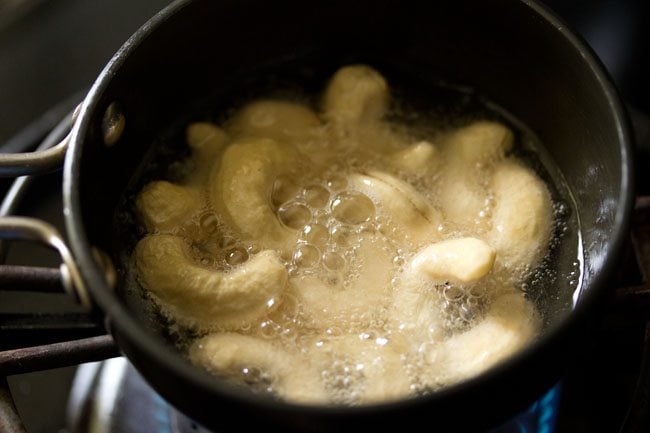

12. Fry till the cashews begin to turn golden.
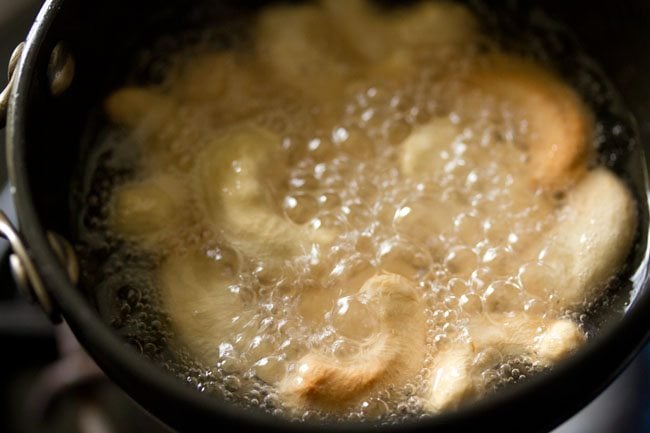

13. Once the cashews start becoming golden, add 1 tablespoon raisins and ½ teaspoon cardamom powder.
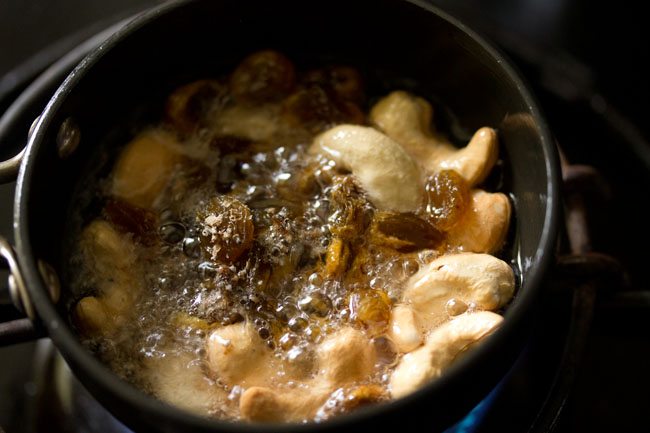

14. Fry the raisins till they swell and become plump.
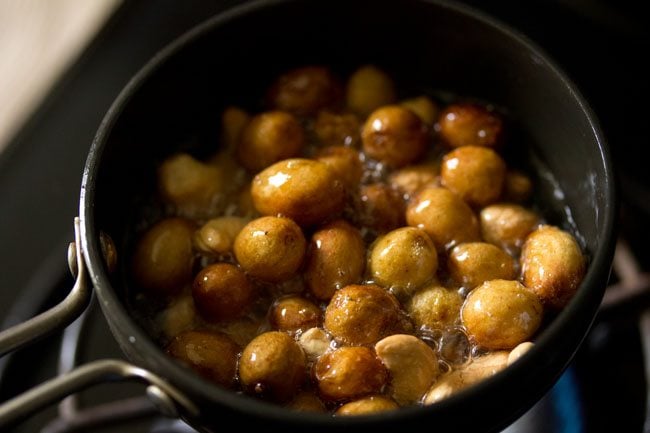

15. Now, pour the fried cashew-raisin mixture with the coconut oil in the payasam.
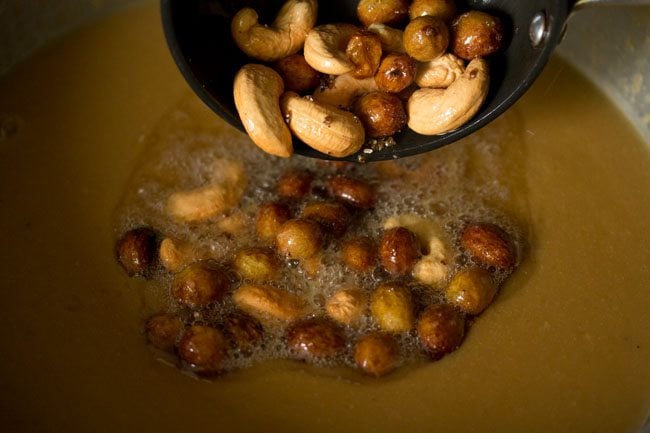

16. Mix very well.
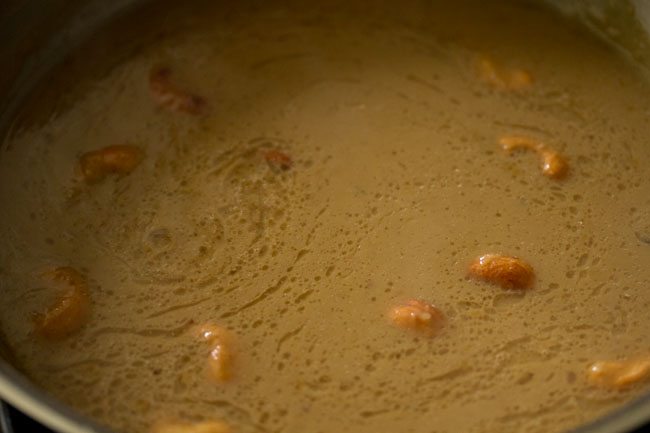

17. Serve Pasi Paruppu Payasam hot or warm. On cooling, the payasam will thicken. Refrigerate it as soon as it comes to room temperature.
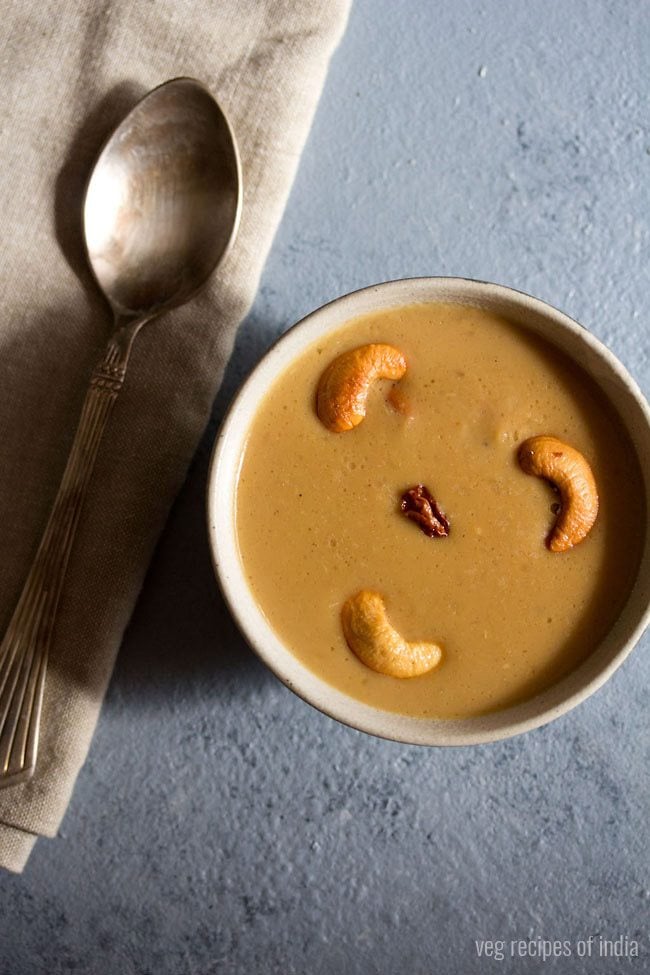

Paruppu in South India
As in any other regional cuisine of India, pulses with lentils (dals), beans, peas, etc. are a staple food for the people of South India too. Classified under the term paruppu, these may be used in the fresh form/sprouted or dried forms as whole, split with husk and split without husk.
A variety of paruppu is used in many recipes of southern India which range from a lentil-vegetable stew or Sambar, batters for popular snacks like idlis, dosas, vadas, etc. and dry veggie-dal dishes to rice based preparations and desserts like Paruppu Payasam, Moong Dal Payasam, etc.
Paruppusilli is a classic stir-fry from the cuisine of Tamil Nadu, made with banana flowers/French or cluster beans, toor dal, Bengal gram, red chilies, curry leaves, mustard seeds and asafoetida. The tradition is to serve it with steamed rice escorted by a buttermilk or curd-based curry called morkuzhambu.
Expert Tips
- No coconut milk? Don’t stress! Use regular dairy milk to make this payasam.
- You have to add milk at room temperature. After adding it to the payasam, simmer just for 1 to 2 minutes and not more, or else the mixture can curdle.
- The moong lentils should be pressure cooked just well, not too pasty or lumpy.
- If the jaggery you are using has impurities, heat it in ⅓ cup water on low flame and stir till it melts. Then, filter and use this syrup.
- You may serve the Moong Dal Payasam hot or warm. Refrigerate only after it comes down to room temperature. Note that on cooling, the payasam thickens.
More Similar Recipes To Try!
South Indian Food
Sweets Recipes
Sweets Recipes
Sweets Recipes
Please be sure to rate the recipe in the recipe card or leave a comment below if you have made it. For more vegetarian inspirations, Sign Up for my emails or follow me on Instagram, Youtube, Facebook, Pinterest or Twitter.
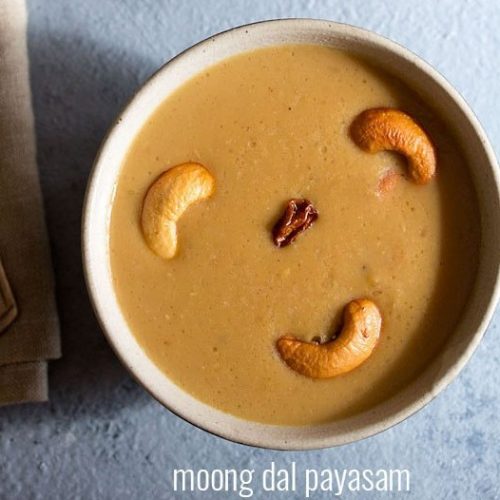

Paruppu Payasam
Delicious creamy moong dal payasam made with yellow moong lentils, jaggery and coconut milk.
Prep Time 15 minutes
Cook Time 5 minutes
Total Time 20 minutes
for cooking moong lentils
Prevent your screen from going dark while making the recipe
cooking moong dal
Rinse 1/2 cup moong dal a couple of times. Take the moong dal and 1 cup water in a small pan.
Place this pan in a pressure cooker. Add 1.5 cups water in the pressure cooker. Pressure cook moong dal for 5 to 6 whistles on medium flame or for 9 to 10 minutes. You can also cook the lentils directly in the cooker. In this case, you can add 1.5 cups water to the lentils and then pressure cook.
When the pressure settles down on its own, remove the lid and check the dal. The lentils should be cooked well.
making paruppu payasam
Pour the entire contents of the small pan (cooked moong dal + water) in another pan or a kadai.
Mash the moong dal with a spoon.
Add 1/2 cup thin coconut milk or water and mix well.
Add 3/4 cup jaggery powder. For a less sweet taste, you can add 1/2 cup jaggery powder or grated jaggery.
Keep the pan or kadai on stove top and on a low flame heat this mixture.
Keep on stirring so that the jaggery dissolves.
Once all the jaggery dissolves, then add 1 cup thick coconut milk.
Mix very well and just gently heat through for a minute or two. Switch off the flame and keep aside. Do not over heat or boil as the coconut milk can curdle.
frying dry fruits
In a small pan or tadka pan, heat 2 tablespoons coconut oil. Add 12 to 15 cashews.
Fry till the cashews begin to get golden.
Once the cashews start becoming golden, add 1 tablespoon raisins and and ½ teaspoon cardamom powder.
Fry the raisins till they become plump and swell.
Now pour the entire content of the tadka pan (coconut oil + cashews + raisins) in the payasam.
Mix very well and serve pasi paruppu payasam hot or warm. Refrigerate the paruppu payasam as soon as it comes to room temperature.
1. Instead of coconut milk you can use milk also. When you add milk then it should be at room temperature and simmer for just 1-2 minutes only. Otherwise it can curdle.
Nutrition Facts
Paruppu Payasam
Amount Per Serving
Calories 646 Calories from Fat 288
% Daily Value*
Fat 32g49%
Saturated Fat 26g163%
Sodium 29mg1%
Potassium 713mg20%
Carbohydrates 80g27%
Fiber 6g25%
Sugar 56g62%
Protein 11g22%
Vitamin A 40IU1%
Vitamin C 2.4mg3%
Calcium 83mg8%
Iron 6.4mg36%
* Percent Daily Values are based on a 2000 calorie diet.

Source link
